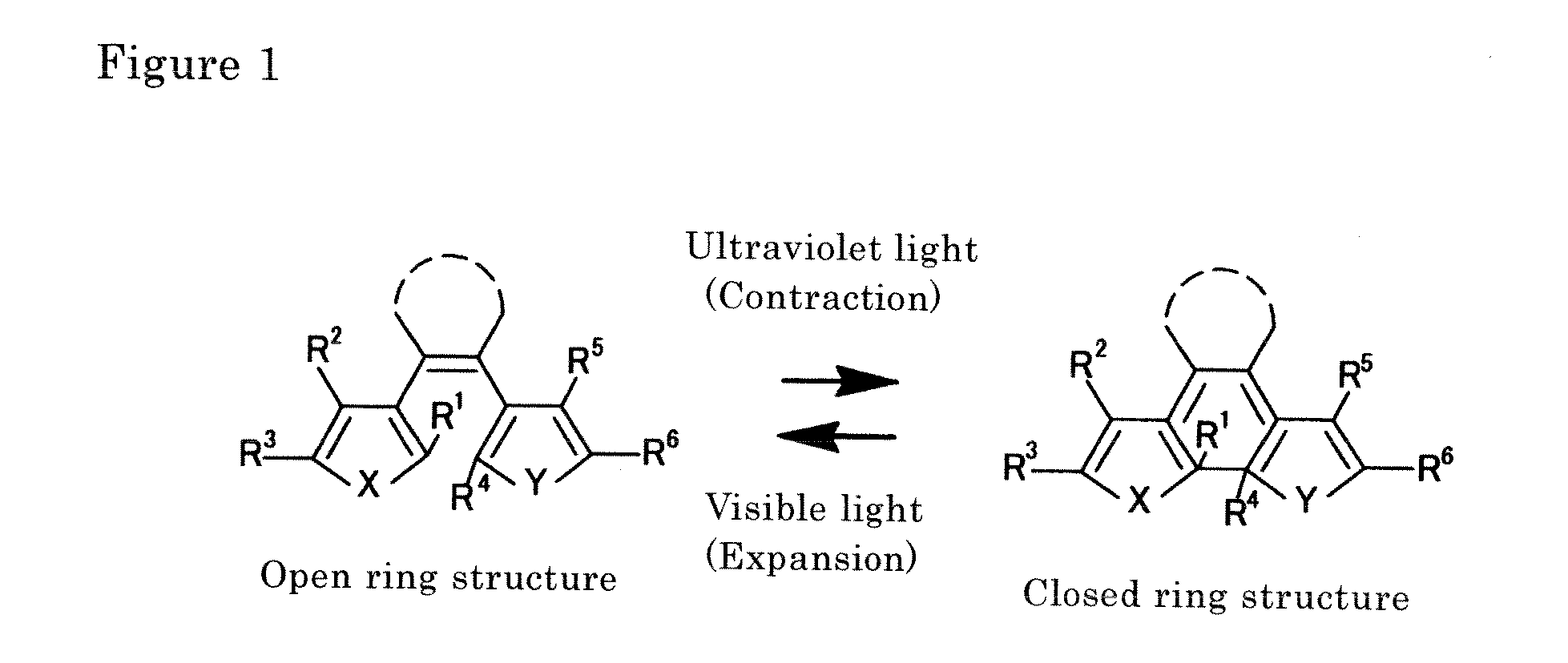Light-activated actuator element
a technology of actuator elements and actuators, applied in machines/engines, solar thermal energy generation, organic chemistry, etc., can solve the problems of difficult configuration of tiny structures, difficult micro-level size reduction of constituent elements, and inability to miniaturize, etc., and achieve the effect of rapid responsiveness
- Summary
- Abstract
- Description
- Claims
- Application Information
AI Technical Summary
Benefits of technology
Problems solved by technology
Method used
Image
Examples
example 1
[0047]Synthesis of Photochromic Compound
[0048]The compound Ia shown in FIG. 3 was synthesized as the crystalline photochromic diarylethene compound used in the light-driven actuator element of the present invention.
Synthesis of 2-phenyl-5-methyl-4-thiazolyl (I-1)
[0049]
[0050]To a three-neck flask under an argon atmosphere were added CuI (210 mg, 1.1 mmol), PdCl2(PPh3)2 (800 mg, 1.1 mmol), and iodobenzene (2.9 g, 14 mmol). Next, using a syringe, distilled DMSO (60 mL), thiazolyl (3 g, 35 mmol) and TBAF (1 M THF solution) 37 mL were added to obtain a mixed solution that was subjected to 5 or 6 cycles of freeze-degassing and stir-heated for 40 hr on a 65° C. oil bath. After the reaction, a large amount of water was added, the organic layer was extracted with diethyl ether, and the extract was dried by addition of anhydrous magnesium sulfate. The product was isolated using a silica gel column (15% AcOEt / hexane). The yield was 84%.
Yellow Oily Product
[0051]1H-NMR (200 MHz, CDCl3) δ 7.89 (m...
example 2
[0061]Photochromic Reactivity Test and Structure Analysis
[0062]The compound (Ia) synthesized in Example 1 was dissolved in hexane, and the solution was concentrated to extract solid crystals by gradually evaporating the solvent. Observation of the deposited colorless crystals with a microscope revealed formation of plate crystals of lozenge shape having 70° and 110° corners. The colorless crystals turned red when irradiated with ultraviolet light (365 nm). The red color was stable and did not fade so long as the crystals were kept in the dark.
[0063]The spectrum shown on the left side of FIG. 4 was obtained by observing the (0-10) face of the crystal colored red by ultraviolet light irradiation under polarized light (linearly polarized light). Thus it was found that red appears at a specific angle and disappears when the angle is rotated by 90°. Measurement of the red alignment coefficient (A1−A2) / (A1+2A2) at 550 nm gave the very high value of 0.73. In the definition of the alignment...
example 3
[0068]Crystal Growth and Photosresponsive Shape Change
[0069]Crystals of the compound (Ia) prepared in Example 2 were placed between sheets of paraffin paper and triturated by pounding to increase their surface area. The powdery crystals were placed in a sublimation pan, covered with a cover glass, and slowly heated from room temperature to 145° C. (to near the melting point of 155° C.) using a melting point apparatus. The sublimation pan was a DSC (differential scanning calorimeter) aluminum sample pan having good thermal conductivity. Many fine crystals measuring between a few millimeters and several tens of micrometers adhered to the cover glass, and fine crystals having clean surfaces were obtained. The crystals were of two types, plate and rod-like. They were the same as crystals obtained by recrystallization from hexane and ethanol, respectively, and were determined to be identical from X-ray structure analysis.
[0070]When a plate crystal obtained in the foregoing manner was irr...
PUM
 Login to View More
Login to View More Abstract
Description
Claims
Application Information
 Login to View More
Login to View More - R&D
- Intellectual Property
- Life Sciences
- Materials
- Tech Scout
- Unparalleled Data Quality
- Higher Quality Content
- 60% Fewer Hallucinations
Browse by: Latest US Patents, China's latest patents, Technical Efficacy Thesaurus, Application Domain, Technology Topic, Popular Technical Reports.
© 2025 PatSnap. All rights reserved.Legal|Privacy policy|Modern Slavery Act Transparency Statement|Sitemap|About US| Contact US: help@patsnap.com



